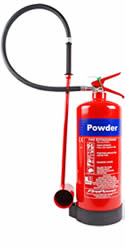 Specialist fire extinguishers are required to tackle Class D flammable metal fires. As you might expect when dealing with such volatile and specialist materials, you need the correct agent for the metal being extinguished.
Specialist fire extinguishers are required to tackle Class D flammable metal fires. As you might expect when dealing with such volatile and specialist materials, you need the correct agent for the metal being extinguished.
However, flammable metals are more common than you might imagine, as under certain conditions, even powdered aluminium or swarf can catch fire.
All powder-based specialist fire extinguishers designed for fighting metal fires are categorised as a powder extinguisher, so are coloured red with the familiar blue panel above the operating instructions. The most common Class D fire extinguishers are 9kg M28 models, whereas the most common UK lithium-extinguishing model is the 9kg L2.
How Do Specialist Metal Fire Extinguishers Work?
Specialist fire extinguishers contain a range of fire extinguishing agents designed to tackle certain metal groups. Metals that burn in air also react with other common compounds in potentially dangerous ways. For example, burning magnesium splits water into oxygen and highly explosive hydrogen gas – not what you want in a fire situation!
Specialist fire extinguishers for metal fires work by smothering the fire with a non-reactive agent, which forms a crust and excludes air from contact with the metals.
Specialist Metals and Their Uses
While you may not encounter such metals as pure magnesium potassium or lithium in everyday situations, they are used extensively in industrial processes, engineering, manufacturing and in scientific laboratories. (Volatile metals are no longer used in school science labs, but ask anyone over 40 and they’ll probably have a tale to tell about chemistry experiments with magnesium…!)
Sodium Chloride fire extinguishers are designed for use on Class D fires involving magnesium, sodium, and potassium. They can also be used on fires involving uranium, and waste (swarf) or powdered aluminium. Swarf can be produced by milling or drilling aluminium, so these fires are a more common hazard than you might expect.
When a sodium chloride fire extinguisher is applied to a fire, the heat of the fire makes the sodium chloride cake together and forms an air-excluding crust. And yes, sodium chloride is just plain table salt (NaCl) and it’s the same sort of process as cooking a fish in salt!
Copper powder metal fire extinguishers are designed for use on Class D fires involving lithium. The powdered copper will coat and extinguisher either a static or flowing lithium fire. In addition, the copper powder will stick to any vertical surface, so if the fire is on a wall, you can still extinguish it safely. Most importantly, the low velocity applicator ensures that no burning metal is blown around, causing the fire to spread.
Graphite powder metal fire extinguishers can also be used on lithium fires, although unlike the copper powder, the graphite powder will not stick to a vertical surface. However, graphite powder can be used on metals that burn at very high temperatures, such as zirconium and titanium.
Sodium bicarbonate and sodium carbonate fire extinguishers can both be used on Class D fires. Sodium bicarbonate extinguishers can be used on most metal alkyls, plus liquids that ignite on contact with air. Sodium carbonate fire extinguishers can be used to extinguish fires involving sodium, potassium, or their alloys.
Granulated fire extinguishing powders can be used in place of extinguishers if the fire is on a level surface. Applied with a long scoop or shovel, granulated sodium chloride, copper and graphite can be applied to smother fires involving titanium, magnesium, potassium sodium and aluminium.
Graphite powder can also be applied to burning metal powders, where even the gentle blast from a fire extinguisher could lift up the powder and cause a dust cloud explosion. Graphite powder has the added advantage of drawing heat away from the fire as well as smothering it.
Sand can also be used to extinguish a burning metal fire in the event of an emergency and if no other suitable agent is to hand. However, sand retains moisture, which in the heat of the fire turns rapidly to steam. The resulting steam eruption could then scatter burning metal over a wider area. Sand should always be applied with a long-handled shovel to protect you from flash burns.
Lithium Fires
Lithium fires must be tackled with a specialist lithium extinguisher only, commonly sold as a L2 extinguisher. A sodium chloride extinguisher is not suitable for use on a lithium fire.
Using a Specialist Fire Extinguisher on a Class D Fire
If your work involves a fire risk covered by a D rated extinguisher, you must be provided with specialist training in the proper use of the extinguisher. These specialist fire extinguishers feature a long lance on the end of a hose, so you can safely tackle the fire from a safe distance. The application of the powder is at low pressure to avoid scattering burning materials.

Recent Comments